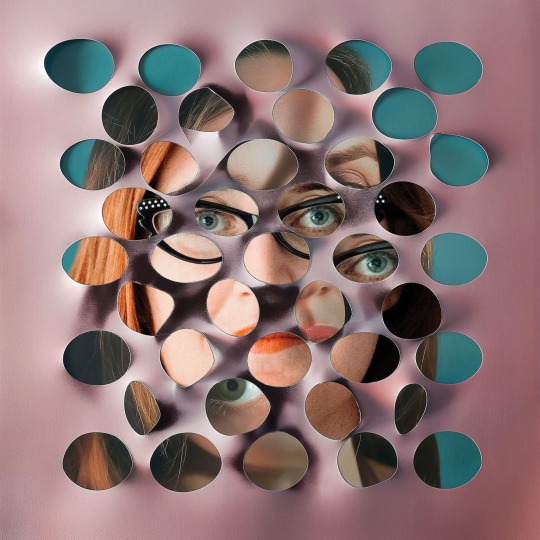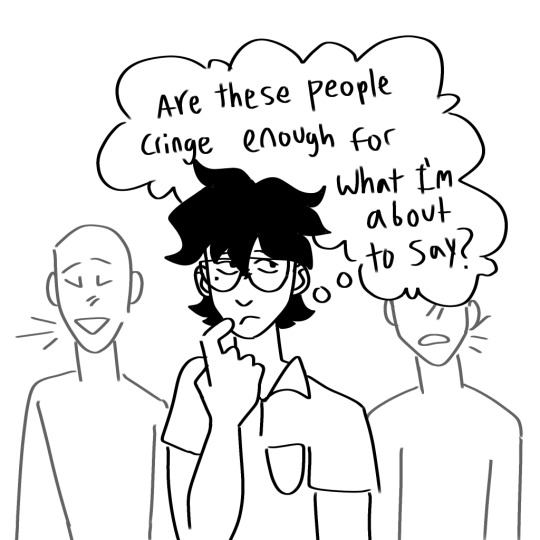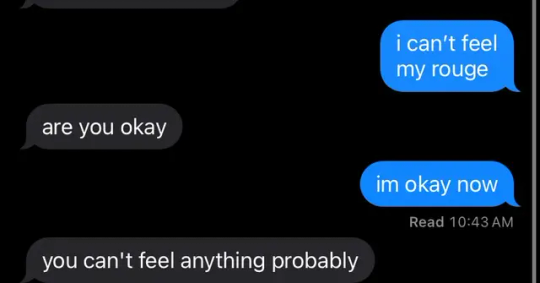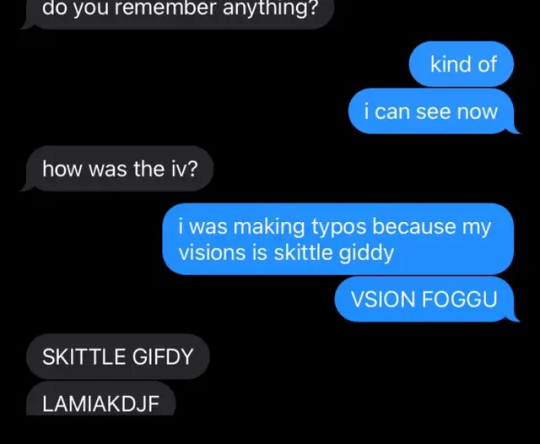#Brain 🧠
Explore tagged Tumblr posts
Text
What Life Is Like When Your Brain Can't Recognize Faces
The common neurological disorder affects roughly 2 percent of the population. Author Sadie Dingfelder shares her perspective navigating the world with it.
— By Sadie Dingfelder | August 6, 2024

An illustration adds an abstract look on top of a photo of author Sadie Dingfelder. Illustration By Matthieu Bourel, Photo By Oxana Ware
Fifteen pairs of eyes stared into the gloaming. An hour passed before someone spied the faintest wisp of smoke on the horizon. The wisp drew closer, becoming something larger, winged, and muscular: sandhill cranes the color of storm clouds, save for their smart red caps. They swirled around our bird blind, a converted shipping container set into the riverbank to hide us from the cranes, and dropped out of the sky in groups of two or three or five, landing gently in the Platte River in central Nebraska.
“It looks like one big mass of birds,” explained our guide from a conservation group called the Crane Trust. “But they actually stay in family groups for their entire migration.”
“How do they keep track of their mates?” I asked.
“They look alike to us, but I bet they look different to each other,” replied a woman in a green coat. I turned away from the birds to study her face. She had wide-set eyes, a ski jump nose, and short gray hair. Was she the same woman I was chatting with on the van ride here, the one who showed me pictures of her dogs?
She was flanked by two similar looking women, and all three were traveling with their own mates—men who were, to me, interchangeably outdoorsy, middle-age, and white. After the cranes melted into the inky darkness, we humans filed silently out of the blind and trekked across a muddy field, our careful footfalls drowned out by a choir of chirping frogs.
Back in the dining hall, we sat speechless, some of us near tears at the beauty we’d seen. As we began to put our collective wonderment into words, I noticed many of my fellow “craniacs” (our term for crane enthusiasts) were calling me by name. It wasn’t strange by any means. After all, we’d spent the past six hours together, chatting over drinks, getting settled in our cabins, and then packing ourselves tightly into vans. But, hard as I tried, I couldn’t draw forth any of their faces or names.
To my eye, humans are nearly as interchangeable as cranes, and I only recently discovered why. I have a neurological disorder known as prosopagnosia, or face blindness. Some people end up with this condition through brain injury, but most cases are genetic in origin—and this version, known as developmental prosopagnosia, affects 2 to 2.5 percent of the population. It touches nearly every aspect of our lives, from dating to networking to making friends, and yet it goes largely undiagnosed. This is because, like most people, folks with face blindness assume that everyone else sees the world the same way as we do. We don’t realize that other people perceive faces as distinctive and highly memorable. A case in point: Bill Choisser, who coined the term “face blind” in the late ’90s, once asked his partner, “Why do TV shows have so many close-ups of actors’ faces? How are we supposed to tell them apart if we can’t see their clothes?”
As a kid, all I knew was that I couldn’t seem to make any friends. I’d hit it off with someone one day and then treat them like a stranger the next. I later found out that my classmates, quite reasonably, thought that I was aloof, or weirdly hot and cold. To fend off loneliness, I would read constantly, usually series like The Baby-Sitters Club or Sleepover Friends. I dreamed of having not just one pal but many. I yearned for the safety of a flock.
In college I abruptly switched strategies—from treating everyone like a stranger to treating everyone like a friend. Walking to class, I’d stop and chat with anyone who so much as glanced my way. It was, I thought, a major improvement. So it went for another 20 years. I knew everyone without really knowing anyone, save a handful of best friends and a boyfriend, all of whom tended to be visually distinctive, or at least very loud. It never occurred to me that this might be a strange way to live.
Not long after I turned 39, I began writing down funny stories from my life, pushing to meet a personal deadline to write a book by 40. Since I was working at the Washington Post at the time, I sent drafts to friends who also happened to be award-winning journalists. They had questions: Why are you always lost? Why do you regularly have no idea who you are talking to? Why is your life shot through with so much ambiguity and confusion?
Other people might have consulted a neurologist, but as a science writer, my first instinct was to sign up for studies. One, run by researchers at Harvard, involved brain scans followed by nearly 30 hours of intensive face-recognition training. My scores in the program improved, but whatever skills I learned during the exercises did not translate to real life. Somehow, I figured out a work-around for tests that were all but impossible given my unusual brain—and this is how I (and most face-blind people) get through life. We figure it out. We adapt.
This is also true for the sandhill cranes. When humans replaced wetlands with farmlands, the birds adapted their diet to include crops like corn. The sandhills, however, are uncompromising in at least one regard: They need wide, shallow waterways to roost in—and that’s why, during much of the year, Crane Trust staff mow down saplings and prevent shrubbery from rooting along the riverbanks. As a result of this adaptability and assistance, sandhill crane populations have been steadily increasing every year.
While I don’t require much accommodation these days, except for the occasional name tag, I do worry about all the lonely face-blind kids out there—as well as people who have other neurological differences. What could we as a society do to make the world more hospitable to the largely unacknowledged diversity of human brains and minds? Where should we be clearing riverbanks?
It was late when we got back to our cabins, but I was still curious about the cranes. I skimmed a few papers before going to bed, and I discovered that cranes probably do look alike, even to each other. But their calls are distinctive. Each bird has its own signature sound, and their voices can carry for miles. This is how cranes keep track of their family members throughout their migration—not with their eyes but their ears.
I should have known. While the cranes looked the same to me, I noticed one particular bird that stretched its neck long and made a sound like an angry clarinet. “It looks like he doesn’t like where his family has roosted,” my friend in the green jacket observed. It was impossible to know, but I suspected she was right. The world is a cacophony of consciousnesses, all so different from your own. But sometimes, if you’re quiet, perceptive, and lucky, you can hear another singular voice piping through the din. I drifted to sleep that night feeling a deep kinship with the cranes, comforted by the knowledge that while my vision may sometimes fail me, my curiosity never will.
3 notes
·
View notes
Text
Sharper Focus and Increased Energy: My Experience with Fast Brain Booster

Boosting Brainpower, Not My Waistline
Looking for ways to improve my focus and concentration, I stumbled upon Fast Brain Booster. Dietary supplements for cognitive function are a dime a dozen, but what intrigued me about Fast Brain Booster was its claim to enhance focus without the jitters or energy crashes often associated with stimulants.
A Natural Approach to Cognitive Enhancement
Fast Brain Booster ditches the artificial ingredients and relies on a blend of natural, science-backed nootropics. These include ingredients like Bacopa monnieri, known for its potential to improve memory and learning, and Lion's mane mushroom, which has been studied for its neuroprotective properties. While more research is needed, these ingredients seemed promising for someone like me seeking a natural cognitive boost.
Improved Concentration and Sharper Thinking
After incorporating Fast Brain Booster into my routine for a few weeks, I noticed a significant improvement in my concentration. Tasks that previously demanded a struggle to stay focused became more manageable. My thoughts felt sharper, and I was able to process information more efficiently. This newfound mental clarity helped me be more productive at work and tackle daily challenges with a renewed sense of focus.
Sustained Energy Without the Crash
One of the biggest concerns I had with trying a brain booster was the potential for an energy crash later in the day. Thankfully, Fast Brain Booster provided a sustained boost in energy that wasn't jittery or overwhelming. It felt more like a natural alertness, allowing me to power through my day without the afternoon slump I often experienced.
Easy to Take and Integrate into My Day
Fast Brain Booster comes in convenient capsule form, making it incredibly easy to incorporate into my daily routine. I typically take one capsule in the morning with breakfast. This simple addition has made a noticeable difference in my overall cognitive performance.
A Valuable Tool for Busy Minds
Fast Brain Booster isn't a replacement for a healthy lifestyle or adequate sleep. However, for those seeking a natural way to enhance focus, improve concentration, and experience sustained energy levels, it can be a valuable tool. Whether you're a student cramming for exams, a professional chasing deadlines, or simply someone looking to sharpen your mental edge, Fast Brain Booster could be a great addition to your wellness routine.
A Blend of Natural Ingredients for Brainpower
Fast Brain Booster appealed to me because it contained a blend of natural ingredients known to support brain health. These included Bacopa monnieri, known for its memory-enhancing properties, and L-theanine, an amino acid that promotes relaxation and focus. Additionally, the formula boasted B vitamins, essential for energy production and cognitive function.
Improved Concentration and Mental Clarity
After incorporating Fast Brain Booster into my routine for about two weeks, I began to notice a positive shift. The brain fog started to lift, replaced by a newfound sense of mental clarity. I found myself able to concentrate on tasks for longer periods without feeling overwhelmed. My ability to recall information also seemed to improve, allowing me to tackle complex projects with renewed confidence.
Enhanced Energy Levels and Reduced Fatigue
Beyond the cognitive benefits, I also experienced a noticeable boost in energy levels. The afternoon slump that often plagued me became a thing of the past. I felt more motivated and engaged throughout the day, allowing me to be more productive both at work and in my personal life. This revitalized energy came without any jitters or the crash often associated with caffeine.
Easy to Take and Integrate into My Day
Fast Brain Booster comes in convenient capsule form, making it incredibly easy to integrate into my daily routine. I simply take two capsules with breakfast, and that's it. The capsules are small and easy to swallow, and there's no unpleasant aftertaste. The simple addition of these capsules has made a significant difference in my overall well-being.
A Word on Sustainability and Long-Term Benefits
It's important to note that while I experienced positive effects within a few weeks, Fast Brain Booster is intended for long-term use. I believe the cumulative benefits will continue to improve cognitive function and overall brain health. Combined with a healthy diet and regular exercise, Fast Brain Booster has become a valuable tool for maintaining a sharp mind and an energized spirit.
Disclaimer: It's important to consult with your doctor before taking any dietary supplement, especially if you have any underlying health conditions or are taking medication.
Struggling with Brain Fog? You're Not Alone
Juggling work, family, and personal commitments can leave anyone feeling ...
A Natural Solution for Enhanced Cognitive Performance
Fast Brain Booster is a dietary supplement formulated with a blend of natural ingredients scientifically linked to improved cognitive function. Some of the key ingredients include Bacopa monnieri, known to support memory and learning, and Phosphatidylserine, which aids in brain cell communication. These plant-based ingredients appealed to me, as I was looking for a safe and natural way to sharpen my mind.
Improved Concentration and Mental Clarity
Within a few weeks of taking Fast Brain Booster daily, I began to experience a positive shift. The brain fog that had been plaguing me started to lift. I noticed an improvement in my ability to concentrate on tasks for longer periods. Information seemed to stick easier, and I felt more mentally alert throughout the day.
Increased Energy Levels and Reduced Fatigue
One unexpected benefit of taking Fast Brain Booster was the boost it gave to my energy levels. Previously, I would often experience a midday slump, leaving me feeling drained and unproductive. However, after using the supplement, I found myself with more sustained energy throughout the day. This allowed me to tackle my to-do list with renewed enthusiasm and reduced fatigue.
Easy to Integrate into My Daily Routine
Fast Brain Booster comes in convenient capsule form, making it simple to incorporate into my daily routine. I typically take it with breakfast, and it doesn't interfere with any medications or other supplements I take.
A Word on Consistency and Individual Results
It's important to remember that everyone's body reacts differently to supplements. Fast Brain Booster may not produce the same results for everyone, and consistency is key. I found the effects to be cumulative, with the benefits becoming more pronounced over time. However, maintaining a consistent intake was essential to experience the full impact.
Overall, a Positive Impact on My Mental Performance
Fast Brain Booster has become a valuable addition to my daily wellness regimen. It's helped me regain my focus, improve my memory, and experience increased energy levels. If you're looking for a natural way to enhance your cognitive performance and feel sharper throughout the day, I highly recommend giving Fast Brain Booster a try.
Boosting Brainpower.
Looking for ways to improve my focus and concentration, I stumbled upon Fast Brain Booster. Dietary supplements for cognitive function are a dime a dozen, but what intrigued me about Fast Brain Booster was its claim to enhance focus without the jitters or energy crashes often associated with stimulants.
A Natural Approach to Cognitive Enhancement
Fast Brain Booster ditches the artificial ingredients and relies on a blend of natural, science-backed nootropics. These include ingredients like Bacopa monnieri, known for its potential to improve memory and learning, and Lion's mane mushroom, which has been studied for its neuroprotective properties. While more research is needed, these ingredients seemed promising for someone like me seeking a natural cognitive boost.
Improved Concentration and Sharper Thinking
After incorporating Fast Brain Booster into my routine for a few weeks, I noticed a significant improvement in my concentration. Tasks that previously demanded a struggle to stay focused became more manageable. My thoughts felt sharper, and I was able to process information more efficiently. This newfound mental clarity helped me be more productive at work and tackle daily challenges with a renewed sense of focus.
Sustained Energy Without the Crash
One of the biggest concerns I had with trying a brain booster was the potential for an energy crash later in the day. Thankfully, Fast Brain Booster provided a sustained boost in energy that wasn't jittery or overwhelming. It felt more like a natural alertness, allowing me to power through my day without the afternoon slump I often experienced.
Easy to Take and Integrate into My Day
Fast Brain Booster comes in convenient capsule form, making it incredibly easy to incorporate into my daily routine. I typically take one capsule in the morning with breakfast. This simple addition has made a noticeable difference in my overall cognitive performance.
A Valuable Tool for Busy Minds
Fast Brain Booster isn't a replacement for a healthy lifestyle or adequate sleep. However, for those seeking a natural way to enhance focus, improve concentration, and experience sustained energy levels, it can be a valuable tool. Whether you're a student cramming for exams, a professional chasing deadlines, or simply someone looking to sharpen your mental edge, Fast Brain Booster could be a great addition to your wellness routine.
0 notes
Text
Same

Me pondering whether or not to out myself as silly with it
3K notes
·
View notes
Text









HYENA MEMES!!!
#brain 🧠 dump#image dump#not my image#gif#moodboard#scenekid#hyena#rawr xd#hyena therian#hyena kin#hyenakin#dank memes#funny memes#memes
174 notes
·
View notes
Text
Sam about Luke and AJ

#shoot from the hip#sam russell#alexander jeremy#luke manning#sfth aj#sfth luke#sfth tom#hamilton musical#this is completely random like no one is going to find this funny but me#my brain likes to make connections#big brain time 🧠
65 notes
·
View notes
Text

One of my favorite movies 🍿
#the breakfast club#a brain 🧠#an athlete#a basket case#a princess 👑#a criminal#who do you like the most#who can you relate 2?
64 notes
·
View notes
Text
youtube
#Youtube#Quiz#Medical Quiz#30–Questions#Anatomy Quiz#Brain 🧠#Heart ♥️#Kidneys#Lung 🫁#Stonach#Eyes 👁️#Foods 🍲🍱🥘#Soda🥤#Juices 🧃
0 notes
Text
GAY SEX GAY SEX GAY SEX GAY SEX GAY SEX
49 notes
·
View notes
Text
I'm flying high off a single compliment from a boy it's PATHETIC
93 notes
·
View notes
Text
big fan of whatever happened to me immediately after coming off of general anesthesia



95 notes
·
View notes
Text
A glimpse into my mind right now









#the beauty#the sheer beauty#is this the rain or my tears#wilmon#prince wilhelm#simon eriksson#young royals#young royals season three#my beloved#wilmon the interracial interclass ship of my dreams and it was#my brain today: 💜🧠💜#always love seeing a healthy interracial couple happy like that#🤎🤍
309 notes
·
View notes
Text
* obsessed w the line delivery here he iz So silly
31 notes
·
View notes
Text
... Uuh...



#I love how my brain has ideas like this in the middle of studying. This is the third one so far#I made meruem a sort of orca bc if I remember correctly orcas are aggressive af and can form-#-gangs n shit and attack things for the hell of it#but if so mean why so pretty...?#my art#artists on tumblr#the legend of zelda#hunter x hunter#crossover#botw#totk#hxh#merukomu#meruem#hxh meruem#komugi#hxh komugi#au#???#zora may#Zora May#what kind of prompt is that? no idea. But I had to get it out of my system#WHY IS IT ALWAYS THINKING 🗣️ 🧠#digital art#fanart#hxh fanart#zelda fanart#my brainworm working overtime fr
41 notes
·
View notes
Text
Wdym the Isle is the only realm outside of Vault that has murals of their elder. Wdym that proves the people of the Isle held a high regard for their elder, furthering the angst of Dawn being disregarded by the others. . Wdym that the Isle clearly was so spiritual they would not desecrate sacred ground, even under pressure of the foreign realms. What. Do. You .mean that even after everything those murals of the other temples remained intact, in the sacred temple of the Isle, even after the betrayal they faced..
#gergh. brain is braining 🧠🕊️#sky cotl#sky: cotl#sky children of the light#that sky game#skyblr#sky elders#isle elder#text post#sky theory#is that a sky theory?#idk#im going a little crazy over Daleth rn gimme a sec#leaf flower rambles
65 notes
·
View notes
